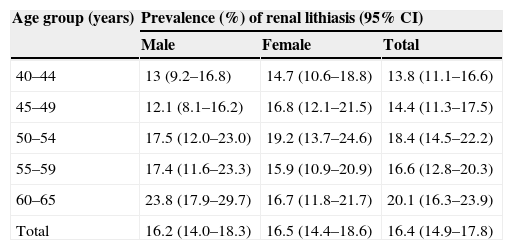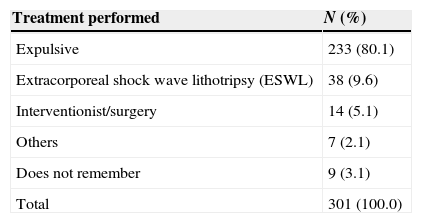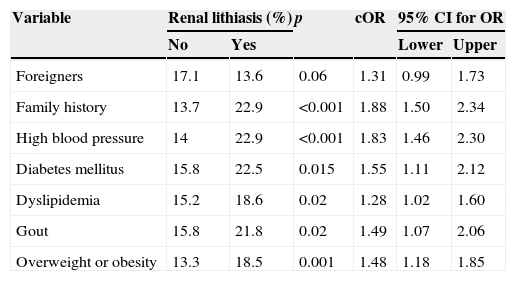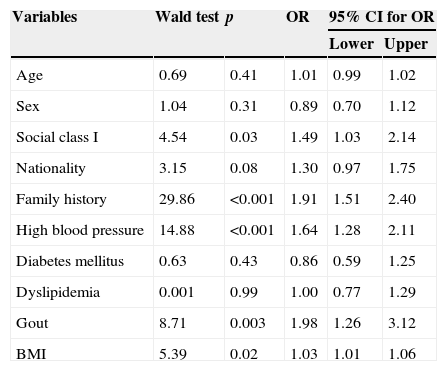Urolithiasis is a disease having a high recurrence rate and associated morbidity. A not well quantified increase is being seen in recent years that could be related with various factors. The main purpose of our study has been to estimate urolithiasis prevalence and incidence in the region of Andalusia, determining which factors are associated.
Material and methodsWe performed an observational and cross-sectional study. Using a multistage randomized procedure, we selected a sample of 2439 subjects, aging from 40 to 65 years old, who currently lived in Andalusia. Data was collected through phone interviews, questioning the chosen subjects about their kidney stones history, comorbidity and socio-demographic characteristics. We conducted a descriptive, bivariate and multivariate analysis with logistic regression.
ResultsA total of 2439 subjects were surveyed. Subjects had mean age of 51.1±7.61 years – standard deviation; (95% confidence interval – 95% CI: 50.70–51.30), 48.7% of whom were male. Prevalence of urolithiasis obtained was 16.4% (95% CI: 14.87–17.85%) and an incidence of 1.2 (95% CI: 0.74–1.64). Variables significantly associated with the presence of urolithiasis found in the multivariate study were: presence of a family history of kidney stones (odds ratio – OR: 1.91; 95% CI: 1.51–2.40, p<.001), hypertension (OR:1.58; 95% CI:1.24–2.02; p<.001), gout (OR:1.98; 95% CI: 1.26–3.12; p=.003) and a high BMI (OR: 1.60; 95% CI 1.19–2.17; p=.008).
ConclusionsA significant increase in the prevalence and incidence of urolithiasis is observed in the environment in regard to the previously available figures. The presence of a family history of urolithiasis, hypertension, gout as well as having a high BMI could influence the observed epidemiological changes in renal lithiasis.
La urolitiasis es una enfermedad con alta tasa de recidiva y gran morbilidad asociada. Se está percibiendo un aumento no bien cuantificado en los últimos años que podría estar relacionado con diversos factores. El objetivo principal fue estimar la magnitud de la urolitiasis en Andalucía y determinar qué factores se hallan asociados.
Material y métodosRealizamos un estudio observacional, transversal. Mediante procedimiento aleatorizado polietápico seleccionamos una muestra de 2.439 sujetos, de 40 a 65 años, residentes en Andalucía. La recogida de datos se realizó mediante encuesta telefónica, interrogando a los sujetos sobre antecedentes de litiasis renal, comorbilidad y características sociodemográficas. Realizamos un análisis estadístico descriptivo, bivariado y multivariado (regresión logística múltiple).
ResultadosFueron encuestados 2.439 sujetos, con una edad media de 51,1±7,61 años-desviación típica (intervalo de confianza al 95% [IC 95%]: 50,70–51,30) de los cuales el 48,7% eran varones. La prevalencia de urolitiasis fue del 16,4% (IC 95%: 14,87–17,85) y la incidencia del 1,2% (IC 95%: 0,74–1,64). Como variables asociadas a la presencia de urolitiasis en el estudio multivariado encontramos la presencia de antecedentes familiares de litiasis renal (odds ratio [OR]: 1,91; IC 95%: 1,51–2,40; p<0,001); la hipertensión arterial (OR: 1,58; IC 95%: 1,24–2,02; p<0,001), padecer gota (OR: 1,98; IC 95%: 1,26–3,12; p=0,003) y un índice de masa corporal elevado (OR: 1,60; IC 95%:1,19–2,17; p=0,008).
ConclusionesSe constata un incremento importante de la prevalencia e incidencia de urolitiasis en nuestro medio con respecto a las cifras que previamente conocíamos. La presencia de antecedentes familiares de urolitiasis, la hipertensión arterial, la gota, unido a un índice de masa corporal elevado, podrían desempeñar un importante papel en los cambios epidemiológicos observados en la litiasis renal.
Artículo
Comprando el artículo el PDF del mismo podrá ser descargado
Precio 19,34 €
Comprar ahora











